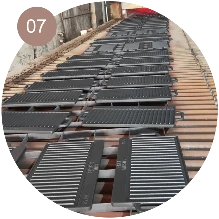
Discover Different Types of Dutch Ovens | Your Ultimate Guide
Different Types of Dutch Ovens A Culinary Essential
Dutch ovens are versatile and indispensable tools in the kitchen, cherished by both professional chefs and home cooks alike. With their heavy-duty construction and exceptional heat retention, these cooking vessels can handle a wide range of culinary tasks. However, not all Dutch ovens are created equal; they come in various types, materials, and designs, each tailored for specific cooking applications. Understanding the different types of Dutch ovens can help you select the perfect one for your culinary needs.
Different Types of Dutch Ovens A Culinary Essential
2. Bare Cast Iron Dutch Ovens For traditionalists, bare cast iron Dutch ovens are often favored due to their exceptional heat retention and natural non-stick surface when well-seasoned. These ovens require more maintenance than enameled versions; they need to be seasoned regularly to prevent rust and enhance their non-stick properties. However, when cared for properly, bare cast iron Dutch ovens can last a lifetime and even get better with age, imparting a distinct flavor to dishes prepared within them.
different types of dutch ovens

3. Aluminum Dutch Ovens Lightweight and often more affordable, aluminum Dutch ovens are an excellent alternative for those who prefer an easier-to-handle option. These pots conduct heat effectively, making them ideal for stovetop cooking. However, they may not retain heat as well as cast iron, so they are often used for baking and frying rather than long simmering or slow-cooking.
4. Stainless Steel Dutch Ovens Another popular choice, stainless steel Dutch ovens are non-reactive, meaning they won't alter the flavor of acidic ingredients. They often come with a thick base to help distribute heat evenly. While they might not offer the same heat retention as cast iron models, their lightweight nature and dishwasher-safe convenience make them a practical choice for everyday cooking.
5. Portable Dutch Ovens Ideal for outdoor enthusiasts, portable Dutch ovens often feature a design that allows for cooking over an open flame or on a campfire. Typically made from cast iron, these ovens come with legs to elevate them over coals and a lid that can hold hot coals for even cooking. They're perfect for stews, roasts, and baked goods, providing a glimpse of rustic cooking tradition.
In conclusion, the type of Dutch oven you choose can significantly impact your cooking experience. Whether you prefer the elegance of enameled cast iron, the durability of bare cast iron, or the convenience of stainless steel, each type offers unique benefits tailored to different culinary endeavors. Investing in the right Dutch oven not only enhances your cooking techniques but also adds a timeless piece to your kitchen collection.
-
Season Cast Iron Perfectly with GPT-4 Turbo TipsNewsAug.01,2025
-
High Quality Cast Iron Cookware - Baixiang County Zhongda MachineryNewsAug.01,2025
-
Premium Cast Iron Pan: Durable & Perfect HeatNewsAug.01,2025
-
High Quality Kitchen Durable Black Round Cast Iron Cookware Pancake Crepe Pan-Baixiang County Zhongda Machinery Manufacturing Co., Ltd.NewsAug.01,2025
-
Cast Iron Cookware - Baixiang County Zhongda Machinery | Nonstick, Heat ResistanceNewsAug.01,2025
-
High Quality Kitchen Durable Black Round Cast Iron Cookware - Baixiang County Zhongda Machinery | Non-Stick, Heat Retention, DurableNewsJul.31,2025


